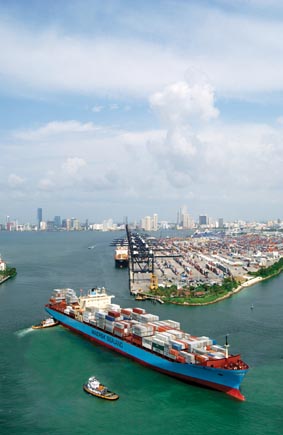Information
Miami - to be first with 50 ft depth
By Rick Eyerdam
 In the year ahead, Miami will move closer to becoming the first container port in the south-eastern United States to offer a depth alongside of 50 ft (15.24 metres).
In the year ahead, Miami will move closer to becoming the first container port in the south-eastern United States to offer a depth alongside of 50 ft (15.24 metres).
Kevin T. Lynskey, recently appointed assistant port director, said the final phase of channel dredging was halfway through the planning, engineering and design stage.
“The port will have a better understanding of what the final dredge cost number will be and at that point we will be looking to the Feds for the normal share of that expense,” said Mr Lynskey.
He estimated that the total cost of channel dredging, from the head pin to the end of the 6,000 ft of linear berth space, would be no more than US$180 million. At that point, some time next year, Miami will be the first East Coast port to be dredged to the new industry standard of 50 ft at normal tide.
Delivery
Two more super post panamax cranes have been ordered for delivery in 2010, bringing the total to six. In order to handle the potential daily volume generated by 10,000 teu class containerships, plans are being drafted to formally establish the footprint for on-port rail system in conjunction with the design and location of the future Port of Miami tunnel entrance. The on-port rail footprint, to be integrated into the master plan next year, calls for parallel 2,500 ft lengths of track connecting with the existing bascule bridge that links the port to the mainland rail system. Plans also include repairs to the bridge.
With the availability of on-port rail and an eventual improvement in traffic flow to and from the facility via the two adjacent Port of Miami tunnels, the port administration has entered talks with Florida East Coast Railway (FEC) and the Flagler development company Coral Gables to identify shippers and carriers essential to support a planned intermodal rail yard and inland port on the western edge of Miami International Airport.
Expansion Plans
According to literature provided by Flagler and the FEC, the Flagler Logistics Hub at the existing FEC rail yard will support the Port of Miami and Miami International Airport expansion plans “by serving as an off-port container yard, an off-airport and possibly on-airport cargo facility as well as an enhanced and non-exclusive intermodal rail facility.”
To become more efficient, the port requires shorter dwell times and longer hours – and that requires warehouses and bonded yards willing and able to accept cargo after sunset and before dawn. Those are the clients the developers will be seeking.
Mr Lynskey said: “We have a pretty solid estimate that we can handle all our anticipated growth through 2035 [the theoretical end date of the master plan] through known technologies within our existing port footprint.”
The “known technologies” include improved gantry cranes, redesigned port access for trains and trucks, modernised terminals capable of automated container movements and longer hours extended as throughput demands. There is no sense buying cranes and digging a channel deep enough for a 10,000 teu containership unless it can discharge at least 10 per cent of its cargo at one terminal. That would require the Port of Miami to clear at least 1,000 containers from the port on any given day. Double stacked, that would require four trains, 100 cars long, and 200 truck journeys, if the port had no other calls that day.
To that end, long-promised improvements at the Seaboard terminal have advanced with such alacrity that the port was able to collect a $1 million bonus for beating its construction timetable.
Negotiations are so near completion that the new long-term lease agreement with the Port of Miami Terminal Operating Company (Pomtoc) will be signed in 2010. With a long-term lease in hand, Ports America, one of the partners in Pomtoc, has said it is willing to fund substantial modernisation and automation of container handling equipment.
“We anticipate that within four months we will have all three container terminals under long-term contract,” said Mr Lynskey.
New Agreements
The long-term contracts also place the Port of Miami in a favourable credit situation. Mr Lynskey explained that, whereas at one time the port survived on a total annual revenue guarantee from cargo and cruise business of about $38 million, the new agreements guaranteed the port about $60 million.
“That is pretty incredible, because the operating budget of the port is only about $70 million,” said Mr Lynskey.










